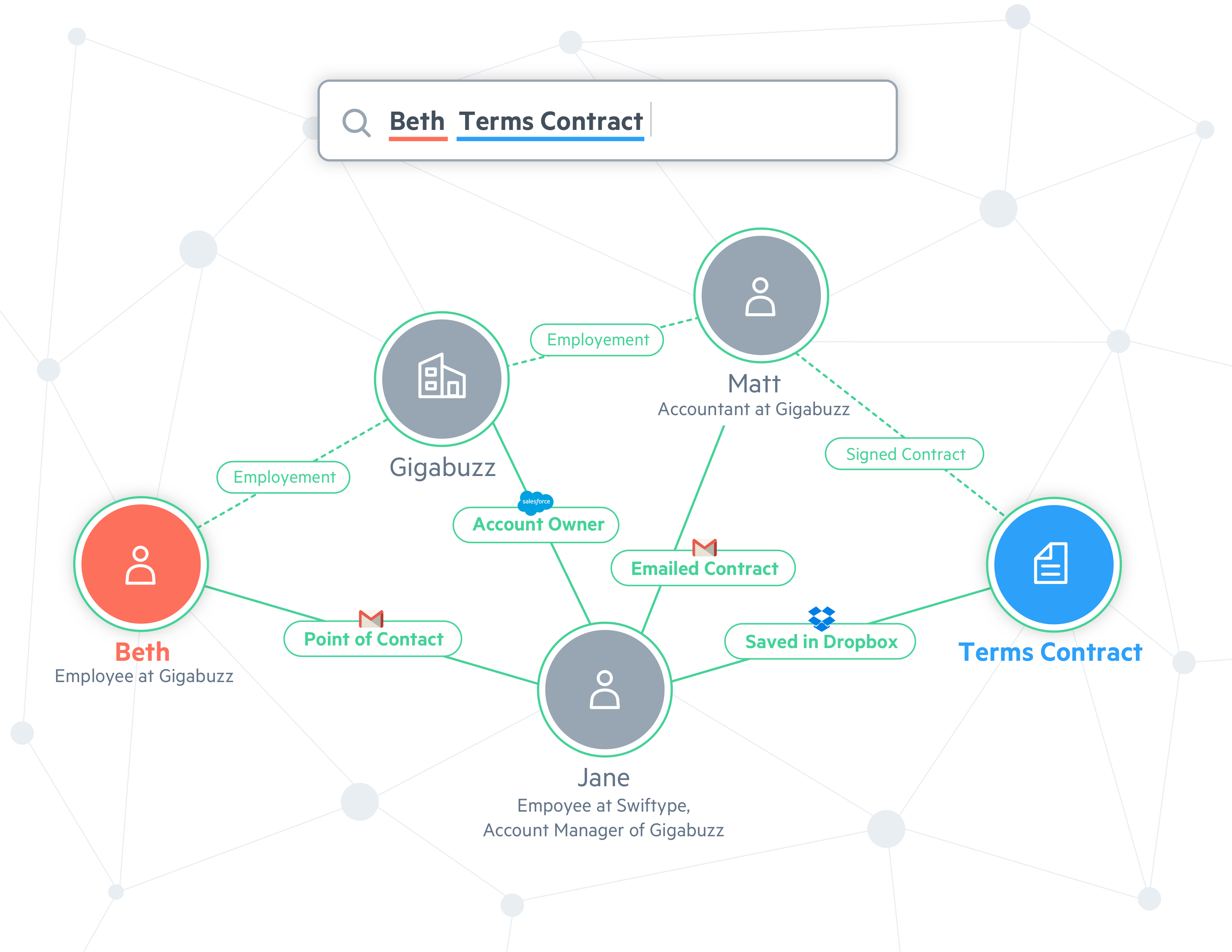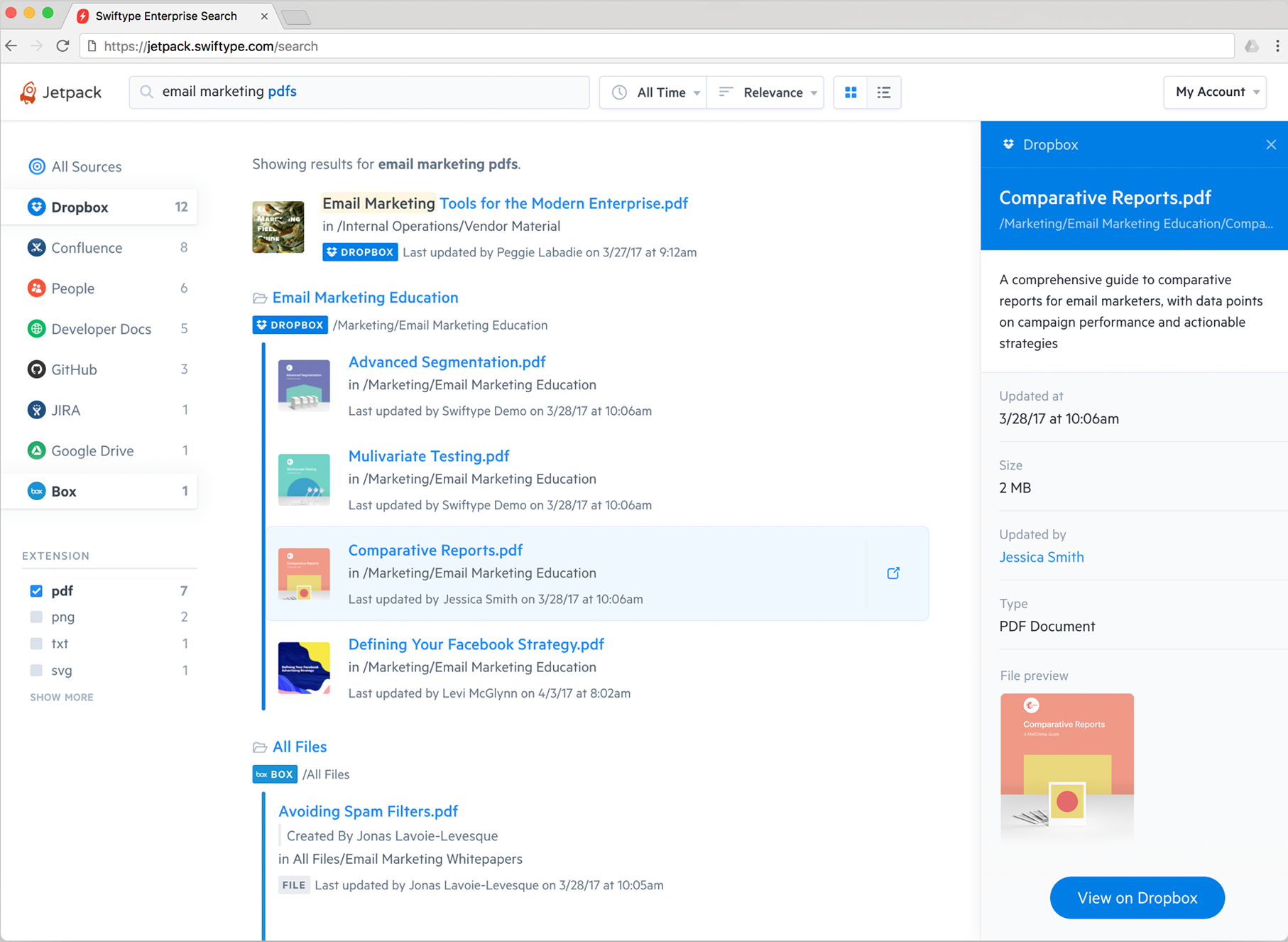
AI and cloud-based technologies are changing the face of the modern enterprise, enabling companies to collaborate more effectively and take on new initiatives that were previously not possible. At Swiftype, we’ve taken our learnings from pioneering hosted site search and used that expertise to build an AI-Powered Enterprise Search solution.
Over the past few months, we’ve generated quite a bit of interest in our next generation enterprise search solution, particularly because it features powerful tech and delivers exceptional ROI. Recently, I spoke at the Silicon Valley Enterprise Search and Analytics Meetup about the many benefits of implementing cloud-based enterprise search within an organization. Here are 7 key takeaways from my talk.
1 – Single point of access for data in your apps, whether it’s in a shared or individual source
“You have customer data [in Salesforce], you have productivity data [in G Drive, Jira and Box], and then you have apps like Evernote, that are individual to a user but still very relevant to their workday. And honestly, if their enterprise search solution is missing [their individual content], then it’s a little bit of a blind spot for them. They may go searching for something that they’re not sure was last saved in Google Drive, Dropbox or in Evernote. A single point of access to that data is crucial for an organization and an employee.”
2 – Cutting down on duplication of work to improve employee satisfaction
“I would say, of all the different kinds of issues that we solve, probably the most disheartening one is when someone goes out and creates some masterpiece of work. They’re working on a project, maybe it’s a document, they spend days crafting it, and then they go turn it in to their boss, and their boss says, “Oh, we already have this. So-and-so did this a month ago. Did you not find that?””
3 – Enterprise search that proactively surfaces relevant files and information while you work
“And the passive aspect of this is one of the most interesting things that we’ve seen with the product. [They’re] probably some of the best anecdotes that I’ve heard from our customers. My favorite one is a customer upsell story. A customer had gone over their limits on a current plan and their sales rep was planning to talk to the customer about an upsell. The sales rep went into the customer’s Account record in Salesforce to find their email address and started typing up an email in their … They were using, I think, the Google apps and Gmail web client. This pops out and shows them a recent support ticket from that day, where that customer had written in about some issue they were having.”
“So they stopped what they were doing, went and talked to the support team, made sure that that issue got resolved, before they sent an email trying to charge them more money. To me, stories like that are pretty amazing, because again, it’s entirely passive. That interaction wouldn’t have happened. They would have sent the email before the issue was resolved.”

4 – Leverage your enterprise knowledge graph and make useful connections between your siloed data sources
“It’s based on what we call our knowledge graph, which I think is a concept that people are [getting] increasingly familiar with. But essentially what we do is, as we are ingesting content from all these different sources that companies are connecting to, we are analyzing it for different entities that exist in them. And what we do is essentially build up a graph of all the entities and relationships within your organization. And it’s become … Again, one of the most interesting things we have in terms of the view of this data, there aren’t many systems out there, aside from enterprise search, that have such a comprehensive view of all the data created in an organization.”
“And it’s great because some of it’s highly structured, so you have a Salesforce account, [which is] highly structured data. But you also have things like PDFs in Dropbox, and that’s unstructured data. What we’ve done is we have this data pipeline that analyzes all this text, and builds the knowledge graph. It exists in many places, so we canonicalize, we clean, and we store data on a knowledge graph that is unique to your organization.”
5 – More productive meetings through technology: Push notifications before meetings
“The mobile app is frequently used for push notifications but it’s also a full blown search interface. Swiftype will look at your calendar and send you content that’s relevant to upcoming meetings and presentations. This popular feature among our customers is also one that I’ve gotten a lot of value from. I get a notification and I know that I don’t have to go searching for what I need, it’s just going to be pushed to me proactively.”
6 – Tracking progress and pushing projects forward: Searching by a colleague’s name
“Where other than a system like enterprise search do you have a comprehensive view of what someone is doing, like all the work they’ve created? In a lot of cases, and again I’m sure this is something that a lot of you can emphasize with, I’ll be working on something and I’ll be thinking Jason shared a file with me and I remember roughly what it is about and I’ve no idea what he named it and I have no idea where he put it, but I know that I worked on it with Jason. That’s how a lot of people think about this stuff, it’s more about collaboration than what a file is named or where it is stored. So we find a lot of these queries and a lot of the browsing centered around a person.”

7 – A platform for productivity: Quickly access the files and information you need
“Something we didn’t see out of the gate, but it came to us pretty quickly through customer feedback, is that people didn’t necessarily want to click a result and jump to some external system. I had assumed that they were trying to jump to wherever the actual destination was, a file, ticket, whatever it was they were trying to get to.”
“What we found was that a lot of people actually wanted information at a glance. There was information that they could get that didn’t require them going deep into whatever that external system was to get it. And it’s not every case, but it was actually a pretty decent percentage of cases. For us, and for the customer, it’s actually a much better experience if we can serve them more immediately within our interface.”
“In the interface you can click a document. You can get a full version of the document, look through it, and get all this information at a glance. We do a lot of metadata extraction and organization of that metadata, based on what your query is. And so we spent a lot of design and engineering time on this interface to try and make it useful to you in whatever your context is. And so again, that may mean not even jumping into these external systems, because we got a lot of questions where they were like, “Oh, but all I need is this piece of information. Why are you going to make me go to Salesforce and then log in and then go to that page? I just need this little piece of information.” So we’ve invested in making as much information available at a glance as we can.”
See how Swiftype can help your company
Want to learn more about Swiftype Enterprise Search? Visit our website for more information and get started with a free trial.